Senators Press FCC on Map That Will Guide Billions in Broadband Infrastructure Funding

A worker for a telecommunications construction company, gets ready to feed a cable underground through a pipe as they install broadband in Boulder as part of the city's gigabit speed broadband buildout on December 6, 2022 in Boulder, Colorado. Photo by RJ Sangosti/MediaNews Group/The Denver Post via Getty Images
State and local officials and others have raised questions about the accuracy of the The Federal Communications Commission map and the process to make corrections to it.
A bipartisan group of 26 U.S. senators on Wednesday wrote the chairwoman of the Federal Communications Commission expressing concern about the accuracy of a map that will be used to determine how billions of dollars in broadband funding from the bipartisan infrastructure law will be divided among states.
The letter, led by Sens. Shelley Moore Capito, a West Virginia Republican, and Jacky Rosen, a Nevada Democrat, urged FCC chairwoman Jessica Rosenworcel to take steps to ensure the reliability of the map, which shows whether and to what extent individual addresses across the nation have high-speed interent service. The senators, for example, urged the FCC to work with stakeholders to make sure all areas of the nation are actually represented on the map.
“We have heard from constituents, state and local governments, and service providers alike of continuing concerns about the accuracy of the map, ranging from persistent issues with missing or incorrect serviceable locations to potentially overstated claims of coverage,” the letter said.
“To ensure the map can be used for decisions about where to direct tens of billions of dollars for broadband deployment, it is critical that these issues be examined and addressed in a systematic and thorough manner,” the senators wrote.
The letter comes after Route Fifty reported earlier this month that state and local officials say they’re seeing discrepancies in the map that have them concerned the money will not go to the places where it’s most needed to give Americans improved access to high-speed internet.
In Vermont, for instance, Robert Fish, deputy director of the state’s broadband office, said in an interview that nearly 22%, or nearly a fourth of the locations in the state, aren’t even on a draft of the FCC’s map, meaning they would not be counted if they have poor service.
Each state in the nation is guaranteed to receive at least $100 million from the $42.5 billion Broadband Equity, Access, and Deployment program in the Infrastructure Investment and Jobs Act to build or improve broadband networks in areas that lack service.
The map showing levels of broadband service around the country is significant because the National Telecommunications and Information Administration will use it to decide by June 30 how to spread around the rest of the money, prioritizing places that are lacking quality service.
Under the FCC’s process, whether or not a location is shown to have adequate internet service speeds is based on input from broadband companies. A process that’s currently underway allows people to appeal information on the map if they believe it’s inaccurate.
But Fish told Route Fifty that relying on companies to provide the information and then waiting for people to file challenges over inaccuracies is a “half-baked.” He noted, for example, that while the map shows some rural parts of Vermont have adequate broadband, that may not be what customers actually experience due to terrain and other factors.
The senators urged Rosenworcel to make sure broadband providers are held accountable if they overreport the level of service in a location.
“Choices as to how billions of broadband dollars will be spent or not will turn on these claims,” the letter said.
The letter did not address concerns raised by state and local officials that they may not have enough time to assess problems with the map. The FCC has encouraged people to file appeals over issues on the map before Jan. 13 to make sure there’s enough time to make fixes to the map before the broadband infrastructure money is distributed.






